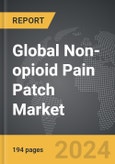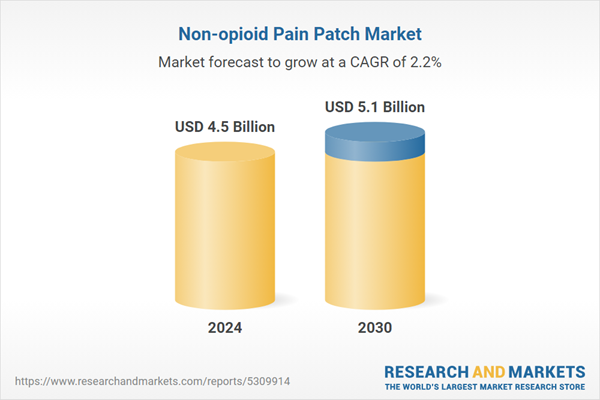Global Non-Opioid Pain Patch Market - Key Trends & Drivers Summarized
What Is a Non-Opioid Pain Patch, and Why Is It So Crucial in Modern Pain Management?
A non-opioid pain patch is a transdermal delivery system designed to deliver medication through the skin to manage pain without the use of opioids. These patches provide a localized and sustained release of active ingredients, such as lidocaine, capsaicin, menthol, and diclofenac, which work to block pain signals or reduce inflammation in the affected area. By offering a non-systemic approach to pain relief, non-opioid pain patches reduce the risk of dependency, side effects, and other complications commonly associated with opioid painkillers.The importance of non-opioid pain patches lies in their ability to provide effective, targeted pain relief while minimizing systemic side effects and addiction risks. As concerns about the opioid crisis continue to grow, the healthcare industry has increasingly focused on safer, alternative pain management solutions. Non-opioid pain patches are widely used for conditions like arthritis, neuralgia, muscle sprains, and post-surgical pain, offering patients a convenient and non-invasive treatment option. With a growing emphasis on non-addictive treatments and chronic pain management, non-opioid pain patches have become an essential tool in both clinical and home settings.
How Are Technological Advancements Shaping the Non-Opioid Pain Patch Market?
Technological advancements have significantly enhanced the design, effectiveness, and application of non-opioid pain patches, driving innovation across the pain management sector. One of the major developments is the improvement in transdermal delivery technology, which has led to more effective and sustained release of active ingredients. Modern pain patches incorporate advanced adhesive materials that ensure better skin adhesion and consistent drug delivery, even in challenging conditions like sweating or movement. This has made non-opioid pain patches more reliable for both short-term pain relief and long-term management of chronic pain conditions.The integration of novel active ingredients and drug formulations has also improved the effectiveness of non-opioid pain patches. For example, advancements in lidocaine formulations have increased its penetration through the skin, enhancing its anesthetic effects for longer durations. Similarly, new formulations of capsaicin have been developed to reduce irritation while maintaining effective pain relief, making them more tolerable for patients with chronic neuropathic pain. Multi-layer patches that combine different active ingredients are being developed to target multiple pain pathways simultaneously, offering broader and more comprehensive pain relief.
Advancements in smart patch technology have introduced wearable, connected pain patches that allow patients and healthcare providers to monitor pain relief in real-time. These smart patches are equipped with sensors that track skin temperature, moisture levels, and drug release rates, providing data to optimize treatment and improve patient compliance. Additionally, micro-needling transdermal systems are being explored to enhance drug penetration for deeper and faster relief, particularly for conditions like osteoarthritis and severe neuralgia. These innovations not only improve the functionality of non-opioid pain patches but also align with broader trends toward personalized, patient-centric, and digital healthcare solutions.
What Are the Emerging Applications of Non-Opioid Pain Patches Across Different Medical Conditions?
Non-opioid pain patches are finding expanding applications across a range of medical conditions, driven by the need for safer and more effective pain management solutions. In musculoskeletal pain, such as arthritis, sprains, and strains, patches containing nonsteroidal anti-inflammatory drugs (NSAIDs) like diclofenac provide targeted relief by reducing inflammation at the site of pain. These patches offer sustained relief for chronic conditions like osteoarthritis, helping patients manage daily pain while minimizing the systemic side effects associated with oral NSAIDs.In neuropathic pain conditions, such as post-herpetic neuralgia, diabetic neuropathy, and nerve damage, non-opioid pain patches containing ingredients like lidocaine and capsaicin are commonly used. Lidocaine patches work by numbing the affected area, blocking pain signals, and providing localized relief without impacting the rest of the body. Capsaicin patches, derived from chili peppers, deplete substance P - a neurotransmitter involved in pain transmission - offering longer-lasting relief for chronic nerve pain conditions. These patches are often used as part of a multimodal pain management strategy to enhance patient outcomes in managing chronic neuropathic pain.
In postoperative pain management, non-opioid pain patches are used to provide localized relief after minor surgeries or invasive procedures. For example, lidocaine patches are applied to surgical incision sites to reduce pain and discomfort, allowing for faster recovery and greater patient mobility. In palliative care, non-opioid patches help manage cancer-related pain without adding to the risk of opioid dependency. The use of non-opioid patches in these settings highlights their role in improving patient comfort and reducing reliance on systemic pain medications.
In sports medicine and rehabilitation, non-opioid pain patches are used to manage acute injuries like muscle strains, tendonitis, and contusions. Menthol and methyl salicylate patches provide cooling and anti-inflammatory effects, making them suitable for athletes seeking quick pain relief without impacting performance. The expanding applications of non-opioid pain patches across these medical conditions underscore their critical role in delivering effective, localized, and safer pain relief across diverse patient populations.
What Drives Growth in the Non-Opioid Pain Patch Market?
The growth in the non-opioid pain patch market is driven by several factors, including increasing awareness of opioid addiction risks, rising prevalence of chronic pain conditions, and advancements in transdermal drug delivery technology. One of the primary growth drivers is the ongoing opioid crisis, which has led healthcare providers, patients, and regulatory agencies to seek safer, non-addictive alternatives for pain management. Non-opioid pain patches offer an effective solution that reduces the risk of dependency, aligns with public health goals, and supports better patient outcomes in managing both acute and chronic pain.The rising prevalence of chronic pain conditions, such as arthritis, back pain, and neuropathic pain, has further fueled demand for non-opioid pain patches. As populations age and lifestyle-related conditions increase, the need for sustained, localized pain relief has become critical for maintaining quality of life. Non-opioid patches provide patients with a convenient and less invasive treatment option that can be used alone or as part of a multimodal pain management approach, supporting broader adoption in both clinical and home settings.
Advancements in transdermal drug delivery technologies have also contributed to market growth by making non-opioid pain patches more effective and user-friendly. Innovations in adhesive materials, drug formulations, and micro-encapsulation techniques have improved the performance, duration, and comfort of pain patches. The development of new active ingredients, combination patches, and smart monitoring features has increased the versatility of non-opioid patches, making them suitable for a wider range of pain conditions and patient needs.
Government regulations, public health initiatives, and increased healthcare funding for pain management have also played a significant role in driving the adoption of non-opioid pain patches. Regulatory agencies have encouraged the development of non-opioid alternatives as part of broader efforts to reduce opioid dependency and promote safer pain management options. Reimbursement policies and insurance coverage for non-opioid treatments have further supported market growth, making these patches more accessible to patients across various healthcare settings.
With ongoing innovations in drug delivery, personalized medicine, and wearable health technology, the non-opioid pain patch market is poised for continued growth. These trends, combined with increasing demand for safer, effective, and localized pain relief options, make non-opioid pain patches a vital component of modern pain management strategies across diverse patient populations and medical conditions.
Report Scope
The report analyzes the Non-opioid Pain Patch market, presented in terms of market value (USD Thousand). The analysis covers the key segments and geographic regions outlined below.Segments
Distribution Channel (Hospital Pharmacies, Online Pharmacies, Independent Pharmacies & Drug Stores); Patch Type (Lidocaine Patches, Diclofenac Patches, Methyl Salicylate Patches, Capsaicin Patches, Ketoprofen Patches, Other Patch Types).Geographic Regions/Countries
World; United States; Canada; Japan; China; Europe (France; Germany; Italy; United Kingdom; Spain; Russia; and Rest of Europe); Asia-Pacific (Australia; India; South Korea; and Rest of Asia-Pacific); Latin America (Argentina; Brazil; Mexico; and Rest of Latin America); Middle East (Iran; Israel; Saudi Arabia; United Arab Emirates; and Rest of Middle East); and Africa.Key Insights:
- Market Growth: Understand the significant growth trajectory of the Lidocaine Patches segment, which is expected to reach $1.5 Billion by 2030 with a CAGR of a 2.6%. The Diclofenac Patches segment is also set to grow at 2.1% CAGR over the analysis period.
- Regional Analysis: Gain insights into the U.S. market, valued at $1.2 Billion in 2024, and China, forecasted to grow at an impressive 4% CAGR to reach $1 Billion by 2030. Discover growth trends in other key regions, including Japan, Canada, Germany, and the Asia-Pacific.
Report Features:
- Comprehensive Market Data: Independent analysis of annual sales and market forecasts in USD from 2024 to 2030.
- In-Depth Regional Analysis: Detailed insights into key markets, including the U.S., China, Japan, Canada, Europe, Asia-Pacific, Latin America, Middle East, and Africa.
- Company Profiles: Coverage of major players such as Acorda Therapeutics, Inc., Allergan PLC, Endo Pharmaceuticals, Inc., GlaxoSmithKline PLC, Hisamitsu Pharmaceutical Co., Inc. and more.
- Complimentary Updates: Receive free report updates for one year to keep you informed of the latest market developments.
Why You Should Buy This Report:
- Detailed Market Analysis: Access a thorough analysis of the Global Non-opioid Pain Patch Market, covering all major geographic regions and market segments.
- Competitive Insights: Get an overview of the competitive landscape, including the market presence of major players across different geographies.
- Future Trends and Drivers: Understand the key trends and drivers shaping the future of the Global Non-opioid Pain Patch Market.
- Actionable Insights: Benefit from actionable insights that can help you identify new revenue opportunities and make strategic business decisions.
Key Questions Answered:
- How is the Global Non-opioid Pain Patch Market expected to evolve by 2030?
- What are the main drivers and restraints affecting the market?
- Which market segments will grow the most over the forecast period?
- How will market shares for different regions and segments change by 2030?
- Who are the leading players in the market, and what are their prospects?
Some of the 42 major companies featured in this Non-opioid Pain Patch market report include:
- Acorda Therapeutics, Inc.
- Allergan PLC
- Endo Pharmaceuticals, Inc.
- GlaxoSmithKline PLC
- Hisamitsu Pharmaceutical Co., Inc.
- IBSA Institut Biochimique SA
- Mylan NV
- Pfizer, Inc.
- TEH SENG Pharmaceutical Mfg. Co., Ltd.
- Teikoku Seiyaku Co. Ltd.
Table of Contents
Companies Mentioned (Partial List)
A selection of companies mentioned in this report includes, but is not limited to:
- Acorda Therapeutics, Inc.
- Allergan PLC
- Endo Pharmaceuticals, Inc.
- GlaxoSmithKline PLC
- Hisamitsu Pharmaceutical Co., Inc.
- IBSA Institut Biochimique SA
- Mylan NV
- Pfizer, Inc.
- TEH SENG Pharmaceutical Mfg. Co., Ltd.
- Teikoku Seiyaku Co. Ltd.
Table Information
| Report Attribute | Details |
|---|---|
| No. of Pages | 194 |
| Published | February 2025 |
| Forecast Period | 2024 - 2030 |
| Estimated Market Value ( USD | $ 4.5 Billion |
| Forecasted Market Value ( USD | $ 5.1 Billion |
| Compound Annual Growth Rate | 2.2% |
| Regions Covered | Global |









